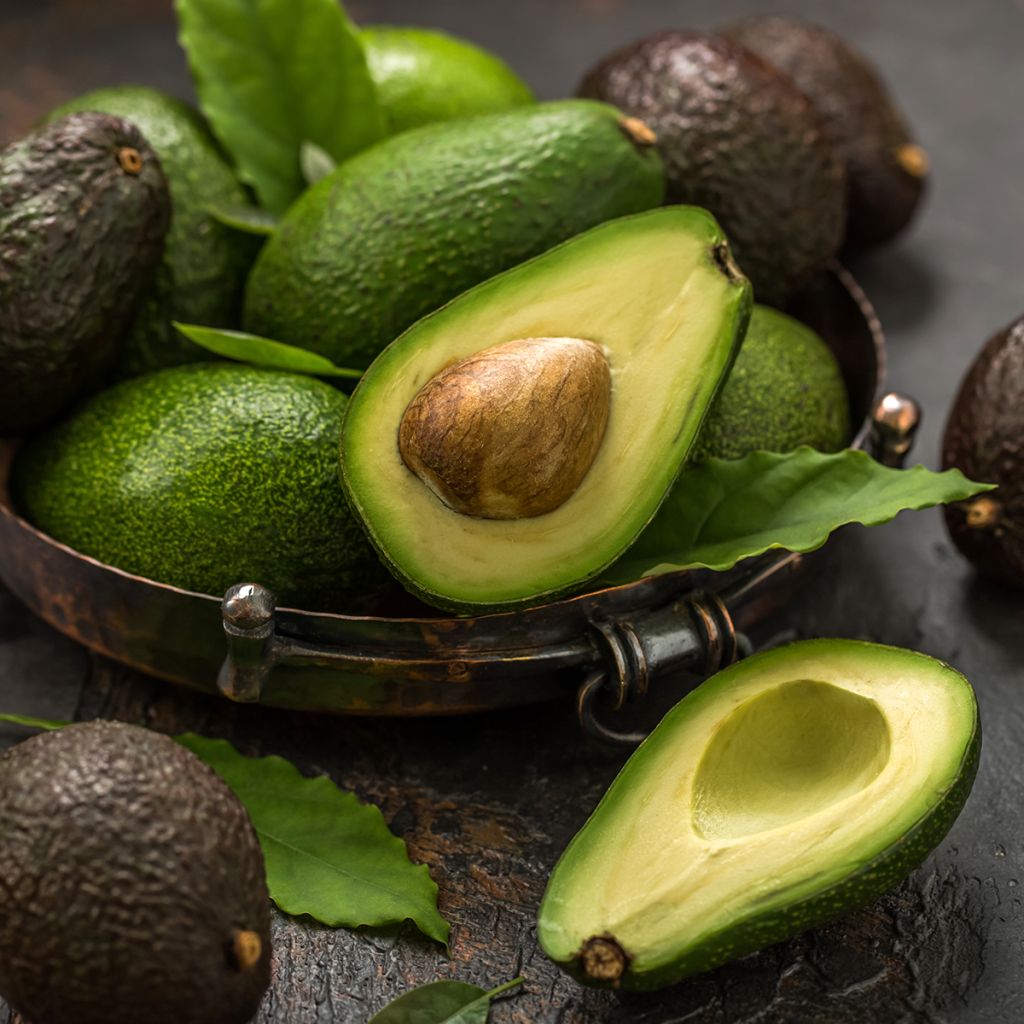

Avocado Tree Hass - Persea americana
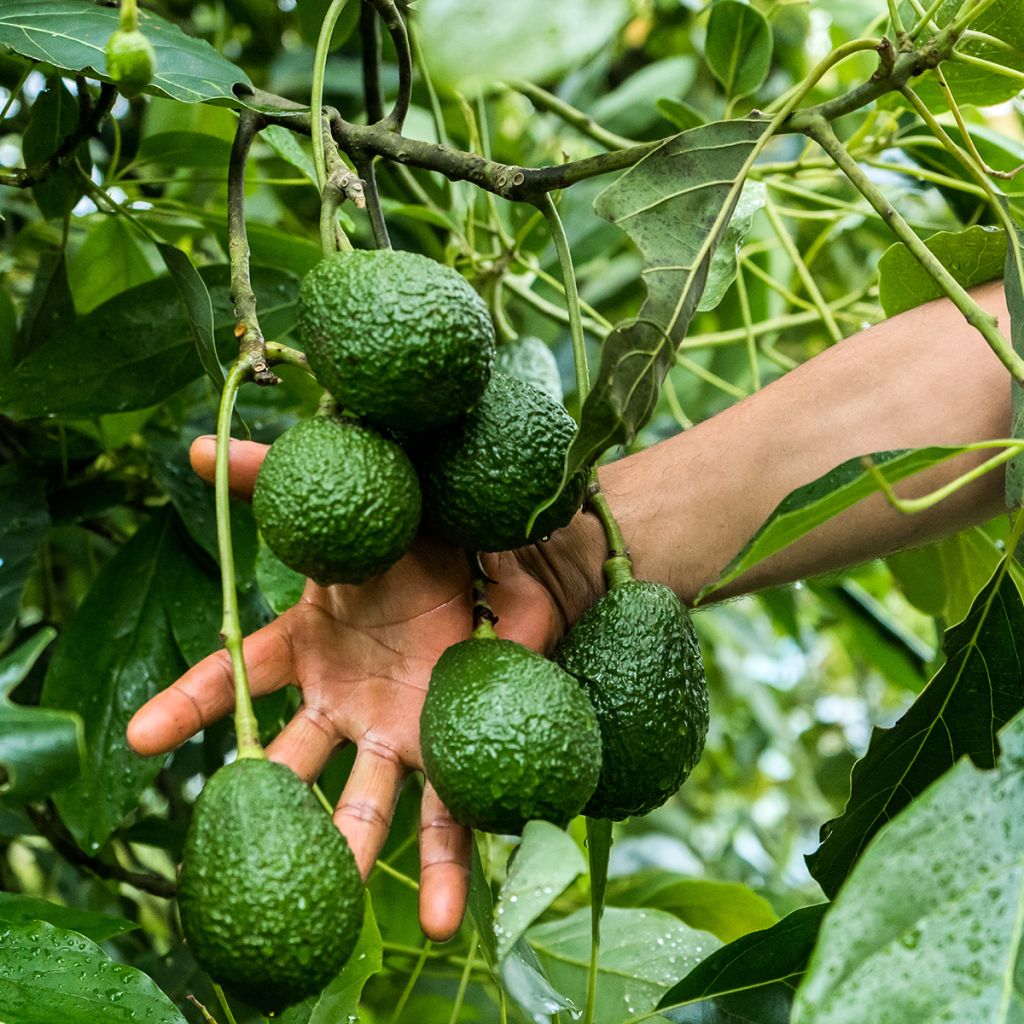

Avocado Tree Hass - Persea americana
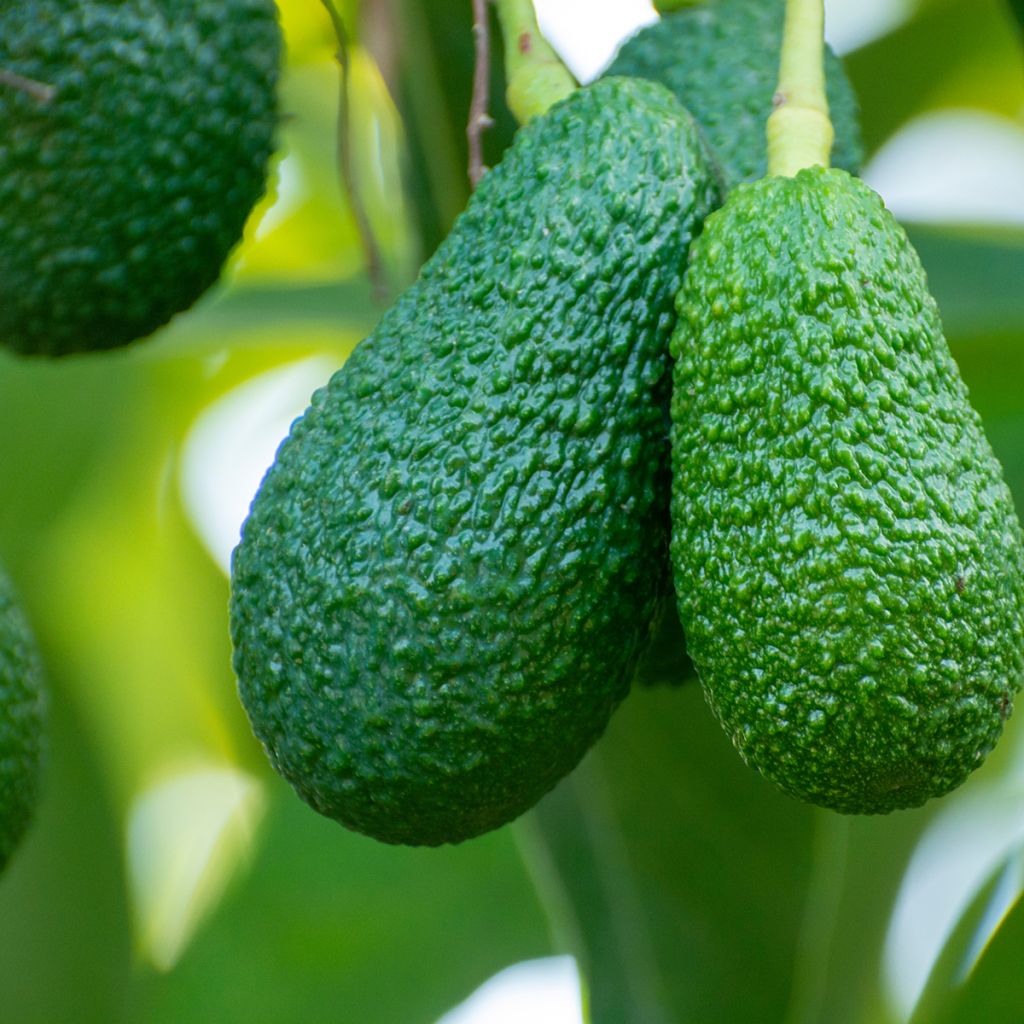

Avocado Tree Hass - Persea americana
Avocado Tree Hass - Persea americana
Persea americana Hass
Avocado Tree
Order in the next for dispatch today!
Dispatch by letter from €3.90.
Delivery charge from €5.90 Oversize package delivery charge from €6.90.
Current delivery delay: 1 day.
More information
This item is not available in your country.
Schedule delivery date,
and select date in basket
This plant carries a 6 months recovery warranty
More information
We guarantee the quality of our plants for a full growing cycle, and will replace at our expense any plant that fails to recover under normal climatic and planting conditions.
From €5.90 for pickup delivery and €6.90 for home delivery
Express home delivery from €8.90.
Description
The Persea americana 'Hass' is a highly regarded variety of Avocado trees, known for the excellence of its fruits, which are also the best-selling in the world. These are the famous 'Hass' avocados with a lumpy skin, turning purplish-brown when ripe. Their flesh is non-fibrous, creamy in texture, with a slightly nutty flavour. The 'Hass' avocado tree can be grown on open ground in the mildest regions, such as the orange zone, as its hardiness is limited to -4°C. Elsewhere, it is cultivated in pots, ideally in a greenhouse or conservatory, or on a well-exposed balcony, sheltered from the wind, before being overwintered frost-free in a very bright room. It is possible to obtain fruits between 4 and 8 years after planting with a good combination of heat and humidity.
The Persea americana is an evergreen tree belonging to the laurel family. It is native to Central America and found in humid forests, from almost sea level up to 2000 m. Depending on its origin, Persea americana is divided into three geographical types, more or less hardy: the Mexican avocado tree (subtropical), the Guatemalan avocado tree (subtropical), and the West Indian avocado tree (tropical). It is intensively cultivated in many subtropical regions and even in the south of Spain, where it is grown for its fruits, avocados, which are rich in lipids, vitamins, and minerals. The avocado tree is a medium-sized tree that can reach twenty metres in height but more often measures about ten metres in its natural environment. Its crown is ample and bushy, its trunk is covered with a grayish and fissured bark. The leaves are alternate, elliptical, entire, with smooth edges, acuminate, measuring 20 to 30 cm by 10 to 15 cm, the base is pointed, the ventral surface is dark green, shiny, the veins are light green, the dorsal surface is dull, glaucous light to white. They fall every year, but after the tree has already formed its new annual foliage, it remains evergreen. Its flowers are successive hermaphrodites and measure from 5 to 10 mm. There are two different types of avocado inflorescences: determinate and indeterminate. In a determinate inflorescence, the end of the shoot that bears the flowers will end in a flower. Indeterminate inflorescences end in a vegetative bud. The avocado fruit is pear-shaped (pyriform), oval or round, 7 to 20 cm long, weighing 100 to 1,000 g. From a botanical point of view, the avocado is a berry with a single seed and not a drupe, as the endocarp is fleshy. It has a large oval central seed, 3 to 5 cm long.
The Persea americana 'Hass' is a renowned variety whose fruits are standard on our stalls. It can reach 7 m in open ground in our latitudes but only 2 to 3 m in height when grown in pots. The fruit is initially green, with a granular skin, then black-brown with violet reflections when ripe. It is climacteric: it only ripens after picking. Harvesting and storing it in a cool and dry space is necessary for it to ripen. The large-sized fruits have firm, stringless flesh. They weigh an average of 300 grams and contain numerous vitamins, minerals, and trace elements. 'Hass' is a self-fertile protogynous cultivar, capable of self-pollination, as its flowers open twice, first as female and then as male. However, it is preferable to cultivate several plants nearby to ensure pollination. It is classified as category A, and it is recommended to plant category B varieties nearby for good pollination, such as 'Bacon', 'Fuerte', or 'Zutano'. Furthermore, fruits will only appear if the tree has sufficient sunlight and high humidity during the initial fruit formation phase.
The Persea americana 'Hass' can only be acclimated in open ground in our mildest winter regions, in warm oceanic or Mediterranean climates. It tolerates frosts of up to approximately -4°C. Elsewhere, it is cultivated in pots like a citrus tree, which allows it to be stored away from frost in winter in a bright but unheated room. A greenhouse can obtain the necessary humidity conditions for fruiting.
Report an error about the product description
Avocado Tree Hass - Persea americana in pictures
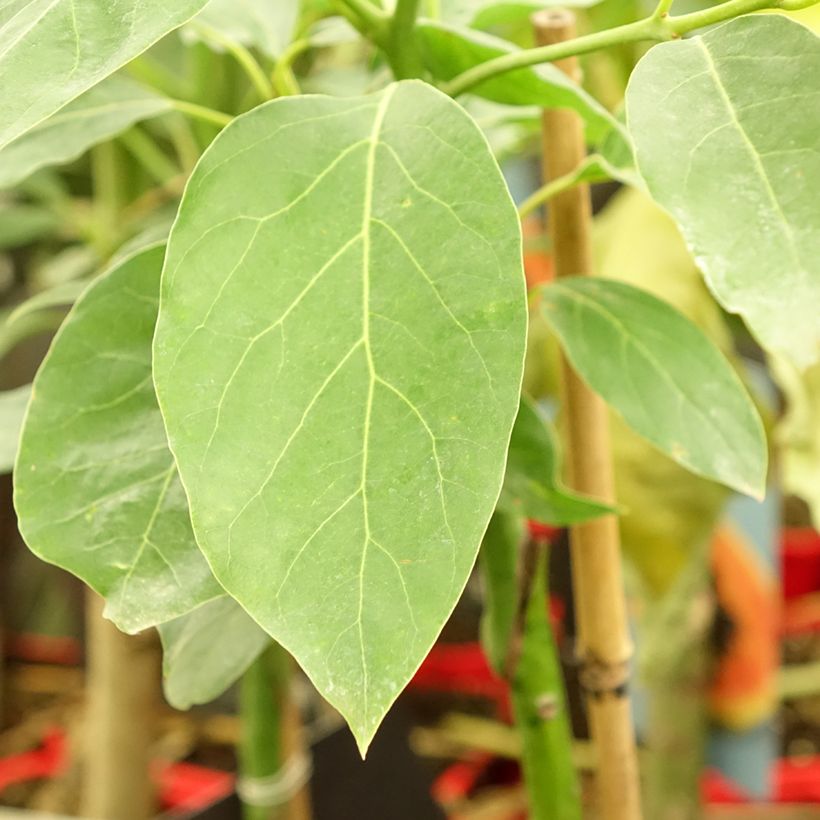

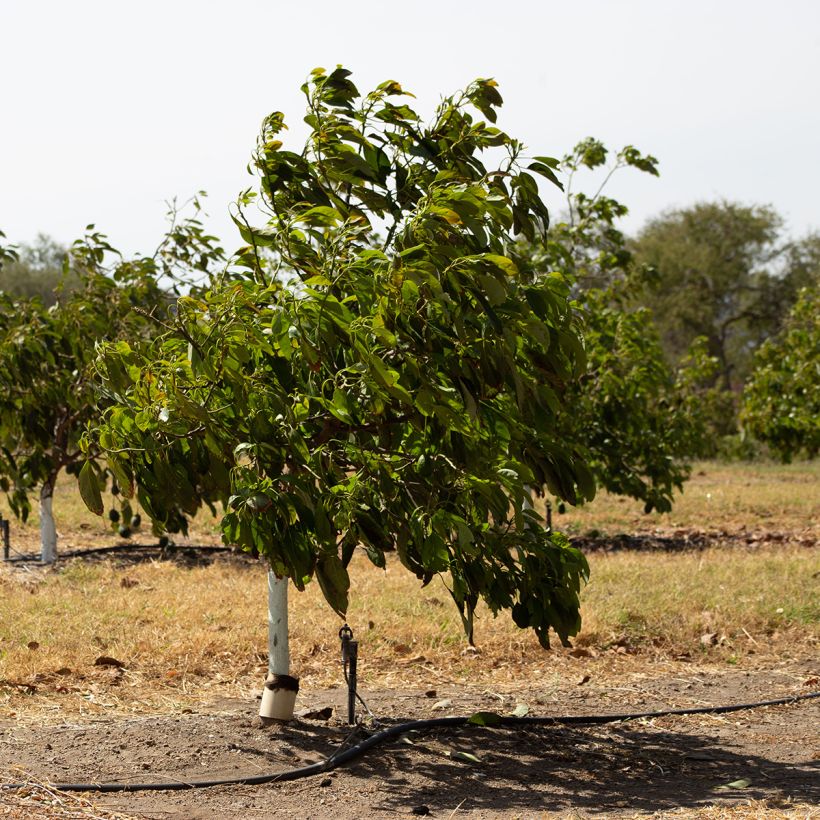



Plant habit
Fruit
Flowering
Foliage
Botanical data
Persea
americana
Hass
Lauraceae
Avocado Tree
Central America
Planting and care
The Persea americana 'Hass' prefers neutral or slightly acidic, well-drained soils. It appreciates fertile, light, deep soils and requires periodic organic amendment and regular watering in summer to bear fruit well.
Choose a very sunny and sheltered location against a well-exposed wall. It is advisable to plant at least two young plants, spacing them 1 m apart for better fruiting. Planting is done in spring.
Dig a hole and add an equal amount of garden soil, sand, and compost. Place the young plant in the hole, cover it with soil, and firm it. Water generously at planting and regularly during the growth period.
In cool or cold regions, it is advisable to cultivate it like a citrus tree in a large pot for wintering, protected from the cold, in a bright but unheated room. Use citrus and Mediterranean plant soil. Fertilise every spring and water your pot regularly.
As for pests, the avocado tree is susceptible to attacks from scale insects, thrips, the Mediterranean fruit fly, and red spiders.
Planting period
Intended location
Care
This item has not been reviewed yet - be the first to leave a review about it.
Haven't found what you were looking for?
Hardiness is the lowest winter temperature a plant can endure without suffering serious damage or even dying. However, hardiness is affected by location (a sheltered area, such as a patio), protection (winter cover) and soil type (hardiness is improved by well-drained soil).

Photo Sharing Terms & Conditions
In order to encourage gardeners to interact and share their experiences, Promesse de fleurs offers various media enabling content to be uploaded onto its Site - in particular via the ‘Photo sharing’ module.
The User agrees to refrain from:
- Posting any content that is illegal, prejudicial, insulting, racist, inciteful to hatred, revisionist, contrary to public decency, that infringes on privacy or on the privacy rights of third parties, in particular the publicity rights of persons and goods, intellectual property rights, or the right to privacy.
- Submitting content on behalf of a third party;
- Impersonate the identity of a third party and/or publish any personal information about a third party;
In general, the User undertakes to refrain from any unethical behaviour.
All Content (in particular text, comments, files, images, photos, videos, creative works, etc.), which may be subject to property or intellectual property rights, image or other private rights, shall remain the property of the User, subject to the limited rights granted by the terms of the licence granted by Promesse de fleurs as stated below. Users are at liberty to publish or not to publish such Content on the Site, notably via the ‘Photo Sharing’ facility, and accept that this Content shall be made public and freely accessible, notably on the Internet.
Users further acknowledge, undertake to have ,and guarantee that they hold all necessary rights and permissions to publish such material on the Site, in particular with regard to the legislation in force pertaining to any privacy, property, intellectual property, image, or contractual rights, or rights of any other nature. By publishing such Content on the Site, Users acknowledge accepting full liability as publishers of the Content within the meaning of the law, and grant Promesse de fleurs, free of charge, an inclusive, worldwide licence for the said Content for the entire duration of its publication, including all reproduction, representation, up/downloading, displaying, performing, transmission, and storage rights.
Users also grant permission for their name to be linked to the Content and accept that this link may not always be made available.
By engaging in posting material, Users consent to their Content becoming automatically accessible on the Internet, in particular on other sites and/or blogs and/or web pages of the Promesse de fleurs site, including in particular social pages and the Promesse de fleurs catalogue.
Users may secure the removal of entrusted content free of charge by issuing a simple request via our contact form.
The flowering period indicated on our website applies to countries and regions located in USDA zone 8 (France, the United Kingdom, Ireland, the Netherlands, etc.)
It will vary according to where you live:
- In zones 9 to 10 (Italy, Spain, Greece, etc.), flowering will occur about 2 to 4 weeks earlier.
- In zones 6 to 7 (Germany, Poland, Slovenia, and lower mountainous regions), flowering will be delayed by 2 to 3 weeks.
- In zone 5 (Central Europe, Scandinavia), blooming will be delayed by 3 to 5 weeks.
In temperate climates, pruning of spring-flowering shrubs (forsythia, spireas, etc.) should be done just after flowering.
Pruning of summer-flowering shrubs (Indian Lilac, Perovskia, etc.) can be done in winter or spring.
In cold regions as well as with frost-sensitive plants, avoid pruning too early when severe frosts may still occur.
The planting period indicated on our website applies to countries and regions located in USDA zone 8 (France, United Kingdom, Ireland, Netherlands).
It will vary according to where you live:
- In Mediterranean zones (Marseille, Madrid, Milan, etc.), autumn and winter are the best planting periods.
- In continental zones (Strasbourg, Munich, Vienna, etc.), delay planting by 2 to 3 weeks in spring and bring it forward by 2 to 4 weeks in autumn.
- In mountainous regions (the Alps, Pyrenees, Carpathians, etc.), it is best to plant in late spring (May-June) or late summer (August-September).
The harvesting period indicated on our website applies to countries and regions in USDA zone 8 (France, England, Ireland, the Netherlands).
In colder areas (Scandinavia, Poland, Austria...) fruit and vegetable harvests are likely to be delayed by 3-4 weeks.
In warmer areas (Italy, Spain, Greece, etc.), harvesting will probably take place earlier, depending on weather conditions.
The sowing periods indicated on our website apply to countries and regions within USDA Zone 8 (France, UK, Ireland, Netherlands).
In colder areas (Scandinavia, Poland, Austria...), delay any outdoor sowing by 3-4 weeks, or sow under glass.
In warmer climes (Italy, Spain, Greece, etc.), bring outdoor sowing forward by a few weeks.




































